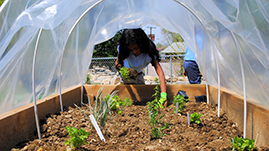Teachers' Domain - Digital Media for the Classroom and Professional Development
User: Preview



Cool weather crops should be strongly considered for school gardens. The traditional school year ends at the time of the cool crop spring harvest and the fall planting season usually begins in August as many students begin a new school year. So students can actively participate in all phases of cool weather gardening from planning to harvest. And, because there are two cool-weather growing seasons, spring and fall, students can participate in two different gardening cycles.
Cool weather crops such as lettuce, peas, carrots, beets, broccoli, and carrots are seasonally suited to the cooler days of spring and fall. They grow best when daytime temperatures are in the 60s or 70s, and they often survive light frosts. Gardeners extend the lives of these vegetables by using hoop houses and other coverings that can protect plants even from hard, killing frosts.
Attempts to grow cool weather crops in summer will result in wilted, shriveled plants. Likewise, attempting to grow summer plants in the cooler months has disappointing results.
Many cool weather crops are “cole crops.” Thinking about coleslaw is a good way to remember this. The Latin root of cole, caulis, means cabbage. Cabbage is part of the mustard family, and anything that’s part of the mustard family is called a cole crop. This family includes cabbage, broccoli, mustard, turnip greens, kale, and Brussels sprouts.
In the chilly days of early spring, starting a school garden may seem impossible, but using raised garden beds and protective coverings minimizes the risk of hard frost and allows students to watch a garden grow from planting to harvest.
 Loading Standards
Loading Standards